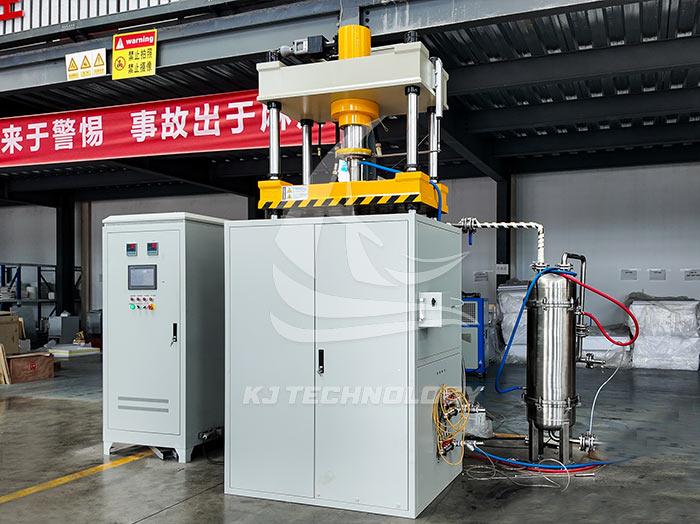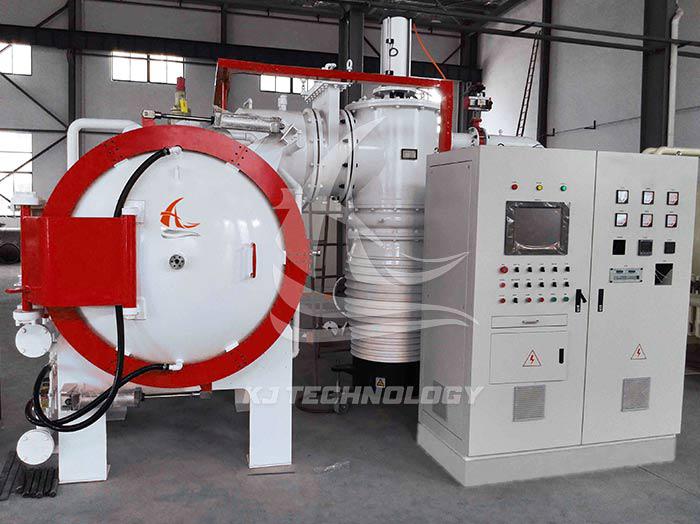What are the advantages of customizing a ceramic sintering vacuum furnace?
 08-28-2025 Author: KJ technology
08-28-2025 Author: KJ technology
The customized ceramic sintering vacuum furnace combines vacuum environment and high-temperature sintering technology, and meets specific process requirements through customized design. Its advantages are reflected in multiple aspects such as material performance improvement, process optimization, equipment flexibility, and long-term benefits, as follows:
1. Significant improvement in material properties
High density and low porosity
The vacuum environment effectively eliminates volatile gases such as water vapor, hydrogen, oxygen, as well as insoluble gases such as carbon monoxide and carbon dioxide in ceramic materials, reduces the formation of pores during sintering, and achieves a ceramic density of over 99%, significantly improving the mechanical strength and hardness of the material.
Case: After vacuum sintering, the bending strength and wear resistance of alumina ceramics can be improved.
Enhanced purity and corrosion resistance
Avoid oxygen, moisture, and impurities in the air from participating in the reaction to prevent oxidation or contamination of ceramic surfaces, especially suitable for the preparation of high-purity ceramics such as electronic ceramics and optical ceramics.
Application: In the semiconductor industry, vacuum sintered aluminum nitride ceramic substrates have become the preferred material for power device heat dissipation due to their high purity characteristics.
Grain refinement and performance optimization
The rapid heating and short holding time in a vacuum environment can suppress excessive grain growth, form small and uniform microstructures, and thus improve the toughness, fracture toughness, and thermal shock resistance of ceramics.
Data: After vacuum sintering, the grain size of silicon nitride ceramics can be controlled below 1 μ m, and the fracture toughness is improved.
2. High process flexibility, adaptable to diverse needs
Support multiple sintering processes
Hot pressing sintering: Applying pressure in a vacuum environment to promote particle contact and reduce sintering temperature, suitable for difficult to sinter materials such as hard alloys and silicon carbide.
Hot isostatic pressing (HIP): By transmitting pressure through high-pressure gas, eliminating internal pores in materials, fully dense and defect free ceramic components are prepared.
Spark Plasma Sintering (SPS): Combining pulse current and pressure to achieve ultra fast sintering (heating rate up to 1000 ℃/min), suitable for the preparation of nanoceramics and functionally graded materials.
Accurate control of temperature and atmosphere
The temperature range is wide (from room temperature to 2300 ℃), which can meet the sintering needs of different ceramic materials such as alumina, zirconia, and silicon nitride.
Supports dual mode operation of vacuum and atmosphere, with the introduction of protective gases such as nitrogen and argon, suitable for atmosphere sensitive ceramic materials (such as nitride ceramics).
Strong ability in non-standard customization
Customize furnace size (such as 80 × 80mm to 500 × 500mm), heating method (resistance/induction/graphite heating), and loading capacity (1kg to 50kg) based on sample size, shape, and production requirements.
Case: A large vacuum furnace customized for the aerospace industry, capable of sintering ceramic turbine discs with a diameter of 1m, meeting the preparation requirements of single large-sized components.
3. Significant energy-saving, environmental protection, and long-term benefits
Reduce sintering temperature and save energy
The vacuum environment has an activating sintering effect, which can reduce the sintering temperature by 100-300 ℃, shorten insulation, and significantly reduce energy consumption.
Data: Compared with traditional sintering furnaces, vacuum furnaces have reduced energy consumption and saved electricity costs per furnace.
Extend equipment lifespan and reduce maintenance costs
Vacuum environment reduces oxidation and corrosion, prolongs the service life of heating elements (such as tungsten wire and graphite) by 2-3 times, and reduces the frequency of spare parts replacement.
Customized design adopts a modular structure, which facilitates quick maintenance and upgrades, reducing downtime.
Improve product qualification rate and reduce waste
The defect rate of ceramic products produced by vacuum sintering is less than 5%, which significantly improves the yield rate and reduces raw material waste compared to traditional sintering.
Case: After a certain enterprise adopted a vacuum furnace, the annual output of ceramic bearing balls increased, the scrap rate decreased, and costs were saved.
4. Widely applied in various fields, promoting technological innovation
High end ceramic manufacturing
Preparation of high-performance structural ceramics (such as ceramic cutting tools, bearings, seals), functional ceramics (such as piezoelectric ceramics, magnetic ceramics), and bioceramics (such as artificial joints, dental implants).
New Energy and Semiconductor Industry
Vacuum sintered aluminum nitride ceramic substrate is used for IGBT module heat dissipation, improving the reliability of power devices.
Preparation of high-purity yttria stabilized zirconia (YSZ) electrolyte membrane for solid oxide fuel cells (SOFC), improving energy conversion efficiency.
Composite Materials and Coating Technology
By combining CVD/PVD technology, hard coatings such as diamond and titanium carbide are deposited on ceramic surfaces to enhance wear resistance and service life.
Preparation of ceramic matrix composites (CMC), such as carbon fiber reinforced silicon carbide ceramics, for use in hot end components of aircraft engines, capable of withstanding temperatures up to 1650 ℃.








